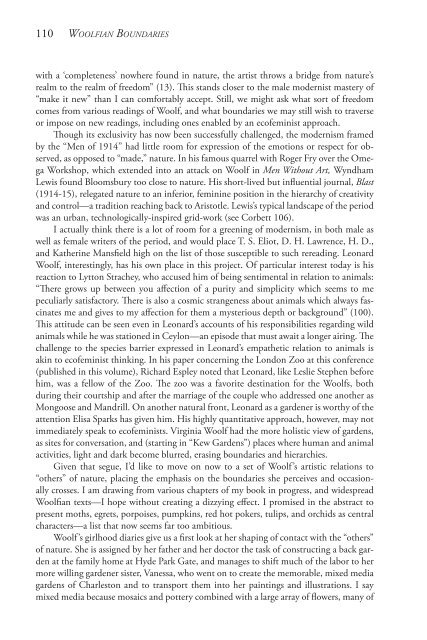Woolfian Boundaries - Clemson University
Woolfian Boundaries - Clemson University
Woolfian Boundaries - Clemson University
You also want an ePaper? Increase the reach of your titles
YUMPU automatically turns print PDFs into web optimized ePapers that Google loves.
110 WOOLFIAN BOUNDARIES<br />
with a ‘completeness’ nowhere found in nature, the artist throws a bridge from nature’s<br />
realm to the realm of freedom” (13). Th is stands closer to the male modernist mastery of<br />
“make it new” than I can comfortably accept. Still, we might ask what sort of freedom<br />
comes from various readings of Woolf, and what boundaries we may still wish to traverse<br />
or impose on new readings, including ones enabled by an ecofeminist approach.<br />
Th ough its exclusivity has now been successfully challenged, the modernism framed<br />
by the “Men of 1914” had little room for expression of the emotions or respect for observed,<br />
as opposed to “made,” nature. In his famous quarrel with Roger Fry over the Omega<br />
Workshop, which extended into an attack on Woolf in Men Without Art, Wyndham<br />
Lewis found Bloomsbury too close to nature. His short-lived but infl uential journal, Blast<br />
(1914-15), relegated nature to an inferior, feminine position in the hierarchy of creativity<br />
and control—a tradition reaching back to Aristotle. Lewis’s typical landscape of the period<br />
was an urban, technologically-inspired grid-work (see Corbett 106).<br />
I actually think there is a lot of room for a greening of modernism, in both male as<br />
well as female writers of the period, and would place T. S. Eliot, D. H. Lawrence, H. D.,<br />
and Katherine Mansfi eld high on the list of those susceptible to such rereading. Leonard<br />
Woolf, interestingly, has his own place in this project. Of particular interest today is his<br />
reaction to Lytton Strachey, who accused him of being sentimental in relation to animals:<br />
“Th ere grows up between you aff ection of a purity and simplicity which seems to me<br />
peculiarly satisfactory. Th ere is also a cosmic strangeness about animals which always fascinates<br />
me and gives to my aff ection for them a mysterious depth or background” (100).<br />
Th is attitude can be seen even in Leonard’s accounts of his responsibilities regarding wild<br />
animals while he was stationed in Ceylon—an episode that must await a longer airing. Th e<br />
challenge to the species barrier expressed in Leonard’s empathetic relation to animals is<br />
akin to ecofeminist thinking. In his paper concerning the London Zoo at this conference<br />
(published in this volume), Richard Espley noted that Leonard, like Leslie Stephen before<br />
him, was a fellow of the Zoo. Th e zoo was a favorite destination for the Woolfs, both<br />
during their courtship and after the marriage of the couple who addressed one another as<br />
Mongoose and Mandrill. On another natural front, Leonard as a gardener is worthy of the<br />
attention Elisa Sparks has given him. His highly quantitative approach, however, may not<br />
immediately speak to ecofeminists. Virginia Woolf had the more holistic view of gardens,<br />
as sites for conversation, and (starting in “Kew Gardens”) places where human and animal<br />
activities, light and dark become blurred, erasing boundaries and hierarchies.<br />
Given that segue, I’d like to move on now to a set of Woolf’s artistic relations to<br />
“others” of nature, placing the emphasis on the boundaries she perceives and occasionally<br />
crosses. I am drawing from various chapters of my book in progress, and widespread<br />
Woolfi an texts—I hope without creating a dizzying eff ect. I promised in the abstract to<br />
present moths, egrets, porpoises, pumpkins, red hot pokers, tulips, and orchids as central<br />
characters—a list that now seems far too ambitious.<br />
Woolf’s girlhood diaries give us a fi rst look at her shaping of contact with the “others”<br />
of nature. She is assigned by her father and her doctor the task of constructing a back garden<br />
at the family home at Hyde Park Gate, and manages to shift much of the labor to her<br />
more willing gardener sister, Vanessa, who went on to create the memorable, mixed media<br />
gardens of Charleston and to transport them into her paintings and illustrations. I say<br />
mixed media because mosaics and pottery combined with a large array of fl owers, many of
















